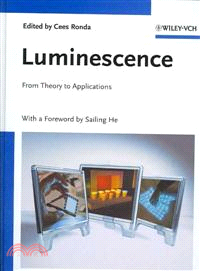Luminescence - From Theory To Applications
商品資訊
ISBN13:9783527314027
出版社:John Wiley & Sons Inc
作者:Ronda
出版日:2007/10/24
裝訂/頁數:精裝/276頁
定價
:NT$ 7712 元優惠價
:90 折 6941 元
若需訂購本書,請電洽客服 02-25006600[分機130、131]。
商品簡介
作者簡介
目次
相關商品
商品簡介
In this, the only up-to-date book on this key technology, the number-one expert in the field perfectly blends academic knowledge and industrial applications.
Adopting a didactical approach, Professor Ronda discusses all the underlying principles, such that both researchers as well as beginners in the field will profit from this book. The focus is on the inorganic side and the phenomena of luminescence behind the manifold applications illustrated here, including displays, LEDs, lamps, and medical applications.
Valuable reading for chemists and electrochemists, as well as materials scientists, those working in the optical and chemical industry, plus lamp and lighting manufacturers.
Adopting a didactical approach, Professor Ronda discusses all the underlying principles, such that both researchers as well as beginners in the field will profit from this book. The focus is on the inorganic side and the phenomena of luminescence behind the manifold applications illustrated here, including displays, LEDs, lamps, and medical applications.
Valuable reading for chemists and electrochemists, as well as materials scientists, those working in the optical and chemical industry, plus lamp and lighting manufacturers.
作者簡介
Cess Rondaobtained a PhD in Solid State- and Theoretical Chemistry at the State University of Groningen, the Netherlands. He joined Philips Research in Eindhoven, the Netherlands in 1986 and moved to Philips Research in Aachen, Germany in 1989. Currently, he is research fellow, one of the highest technical ranks within the Philips Research organisation.
Cess Ronda has worked on luminescent materials for number of applications, his current interest is in liminescent materials for medical applications and for application in Light Emitting Diodes (LEDs).
Apart from working at Philips, he is a professor at Utrecht University (Condensed Matter and Interfaces), the Netherlands and at Zhejiang University (Optical and Electromagnetic Research), China.
Cess Ronda has worked on luminescent materials for number of applications, his current interest is in liminescent materials for medical applications and for application in Light Emitting Diodes (LEDs).
Apart from working at Philips, he is a professor at Utrecht University (Condensed Matter and Interfaces), the Netherlands and at Zhejiang University (Optical and Electromagnetic Research), China.
目次
Foreword.
Preface.
List of Contributors.
1 Emission and Excitation Mechanisms of Phosphors (Cees R. Ronda).
1.1 Introduction.
1.2 General Considerations � Fluorescent Lamps.
1.3 General Considerations � Cathode Ray Tubes.
1.4 Luminescence Mechanisms.
1.5 Excitation Mechanisms.
1.6 Energy Transfer Mechanisms between Optical Centers.
1.7 Excitation with High-energy Particles.
1.8 Electroluminescence (EL).
1.9 Factors Determining the Emission Color.
1.10 Energy Efficiency Considerations of Important Luminescent Devices.
1.11 Luminescence Quantum Yield and Quenching Processes.
1.12 Acknowledgement.
2 Quantum Dots and Nanophosphors (Cees R. Ronda and Thomas Jüstel).
2.1 Introduction.
2.2 Density of States in Low-dimensional Structures.
2.3 Electrons, Holes, and Excitons.
2.4 Low-dimensional Structures.
2.5 Quantum Confinement in Action.
2.6 Photoluminescence of Quantum Dots Prepared by Wet-chemical Precipitation.
2.7 Photoluminescence from Doped Quantum Dots.
2.8 Luminescence of Nano Particles of Rare-Earth Phosphors.
2.9 Nanoscale Particles for Molecular Imaging.
2.10 Conclusions.
2.11 Acknowledgements.
3 Phosphors for Plasma Display Panels (Thomas Jüstel).
3.1 Introduction.
3.2 Principle of Operation of Plasma Display Panels.
3.3 Performance of Applied Phosphors in PDPs.
3.4 Summary and Prospects.
4 Quantum-Splitting Systems (Alok M. Srivastava and Cees R. Ronda).
4.1 Introduction.
4.2 Quantum-splitting Phosphors Based on Pr3+-activated Fluoride Materials.
4.3 Quantum-splitting Phosphors Based on Pr3+-activated Oxide Materials.
4.4 The Quantum Efficiency of the Quantum-splitting Process.
4.5 Limitations of Pr3+-based Quantum-splitting Phosphors.
4.6 Quantum-splitting Phosphors Based on Gd3+ and Rare Earth Ion-Activated Fluoride Materials.
4.7 Multiphoton Emission through High-energy Excitation.
4.8 Applications of Quantum-splitting Phosphors.
4.9 Conclusions.
4.10 Acknowledgements.
5 Scintillators (Cees R. Ronda and Alok M. Srivastava)
5.1 Introduction.
5.2 Positron Emission Tomography and Computed Tomography.
5.3 General Requirements for Scintillating Materials used in Medical Imaging.
5.4 Scintillators for Pet Application.
5.5 Scintillators for CT Application.
5.6 X-ray Intensifying Screens.
5.7 FDXD Detectors.
5.8 Storage Phosphors.
5.9 Semiconductor Scintillators.
6 Upconversion Phosphors (J. Freek Suijver).
6.1 Introduction.
6.2 Theory of Upconversion.
6.3 Examples.
6.4 Conclusions and Outlook.
6.5 Acknowledgements.
7 Luminescent Materials for Phosphor� Converted LEDs (Thomas Jüstel).
7.1 Inorganic Light-Emitting Diodes (LEDs).
7.2 White and Colored LEDs.
7.3 Phosphor-Converted LEDs.
7.4 Future Trends.
8 Organic Electroluminescence (Joseph J. Shiang and Anil R. Duggal).
8.1 Introduction.
8.2 OLED Fundamentals.
8.3 Key OLED Trends and Innovations.
8.4 Prospects for General Illumination.
8.5 Conclusions.
8.6 Acknowledgements.
9 Experimental Techniques (Peter Vergeer)
9.1 Introduction.
9.2 Energy of Optical Transitions: Absorption, Excitation, and Emission Spectroscopy.
9.3 The Transition Dipole Moment: Absorption Strengths and Luminescence Lifetimes.
9.4 Quantum Efficiency and Nonradiative Relaxation.
9.5 Homogeneous Broadening and Dephasing.
9.6 Detection of Luminescence from Individual Optical Centers.
9.7 Acknowledgement.
Index.
Preface.
List of Contributors.
1 Emission and Excitation Mechanisms of Phosphors (Cees R. Ronda).
1.1 Introduction.
1.2 General Considerations � Fluorescent Lamps.
1.3 General Considerations � Cathode Ray Tubes.
1.4 Luminescence Mechanisms.
1.5 Excitation Mechanisms.
1.6 Energy Transfer Mechanisms between Optical Centers.
1.7 Excitation with High-energy Particles.
1.8 Electroluminescence (EL).
1.9 Factors Determining the Emission Color.
1.10 Energy Efficiency Considerations of Important Luminescent Devices.
1.11 Luminescence Quantum Yield and Quenching Processes.
1.12 Acknowledgement.
2 Quantum Dots and Nanophosphors (Cees R. Ronda and Thomas Jüstel).
2.1 Introduction.
2.2 Density of States in Low-dimensional Structures.
2.3 Electrons, Holes, and Excitons.
2.4 Low-dimensional Structures.
2.5 Quantum Confinement in Action.
2.6 Photoluminescence of Quantum Dots Prepared by Wet-chemical Precipitation.
2.7 Photoluminescence from Doped Quantum Dots.
2.8 Luminescence of Nano Particles of Rare-Earth Phosphors.
2.9 Nanoscale Particles for Molecular Imaging.
2.10 Conclusions.
2.11 Acknowledgements.
3 Phosphors for Plasma Display Panels (Thomas Jüstel).
3.1 Introduction.
3.2 Principle of Operation of Plasma Display Panels.
3.3 Performance of Applied Phosphors in PDPs.
3.4 Summary and Prospects.
4 Quantum-Splitting Systems (Alok M. Srivastava and Cees R. Ronda).
4.1 Introduction.
4.2 Quantum-splitting Phosphors Based on Pr3+-activated Fluoride Materials.
4.3 Quantum-splitting Phosphors Based on Pr3+-activated Oxide Materials.
4.4 The Quantum Efficiency of the Quantum-splitting Process.
4.5 Limitations of Pr3+-based Quantum-splitting Phosphors.
4.6 Quantum-splitting Phosphors Based on Gd3+ and Rare Earth Ion-Activated Fluoride Materials.
4.7 Multiphoton Emission through High-energy Excitation.
4.8 Applications of Quantum-splitting Phosphors.
4.9 Conclusions.
4.10 Acknowledgements.
5 Scintillators (Cees R. Ronda and Alok M. Srivastava)
5.1 Introduction.
5.2 Positron Emission Tomography and Computed Tomography.
5.3 General Requirements for Scintillating Materials used in Medical Imaging.
5.4 Scintillators for Pet Application.
5.5 Scintillators for CT Application.
5.6 X-ray Intensifying Screens.
5.7 FDXD Detectors.
5.8 Storage Phosphors.
5.9 Semiconductor Scintillators.
6 Upconversion Phosphors (J. Freek Suijver).
6.1 Introduction.
6.2 Theory of Upconversion.
6.3 Examples.
6.4 Conclusions and Outlook.
6.5 Acknowledgements.
7 Luminescent Materials for Phosphor� Converted LEDs (Thomas Jüstel).
7.1 Inorganic Light-Emitting Diodes (LEDs).
7.2 White and Colored LEDs.
7.3 Phosphor-Converted LEDs.
7.4 Future Trends.
8 Organic Electroluminescence (Joseph J. Shiang and Anil R. Duggal).
8.1 Introduction.
8.2 OLED Fundamentals.
8.3 Key OLED Trends and Innovations.
8.4 Prospects for General Illumination.
8.5 Conclusions.
8.6 Acknowledgements.
9 Experimental Techniques (Peter Vergeer)
9.1 Introduction.
9.2 Energy of Optical Transitions: Absorption, Excitation, and Emission Spectroscopy.
9.3 The Transition Dipole Moment: Absorption Strengths and Luminescence Lifetimes.
9.4 Quantum Efficiency and Nonradiative Relaxation.
9.5 Homogeneous Broadening and Dephasing.
9.6 Detection of Luminescence from Individual Optical Centers.
9.7 Acknowledgement.
Index.
主題書展
更多
主題書展
更多書展今日66折
您曾經瀏覽過的商品
購物須知
外文書商品之書封,為出版社提供之樣本。實際出貨商品,以出版社所提供之現有版本為主。部份書籍,因出版社供應狀況特殊,匯率將依實際狀況做調整。
無庫存之商品,在您完成訂單程序之後,將以空運的方式為你下單調貨。為了縮短等待的時間,建議您將外文書與其他商品分開下單,以獲得最快的取貨速度,平均調貨時間為1~2個月。
為了保護您的權益,「三民網路書店」提供會員七日商品鑑賞期(收到商品為起始日)。
若要辦理退貨,請在商品鑑賞期內寄回,且商品必須是全新狀態與完整包裝(商品、附件、發票、隨貨贈品等)否則恕不接受退貨。
























